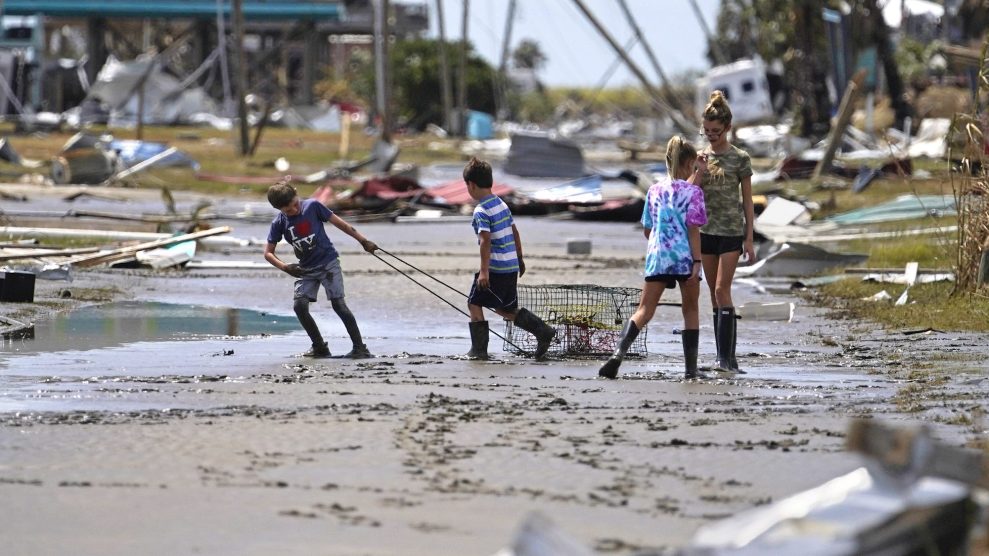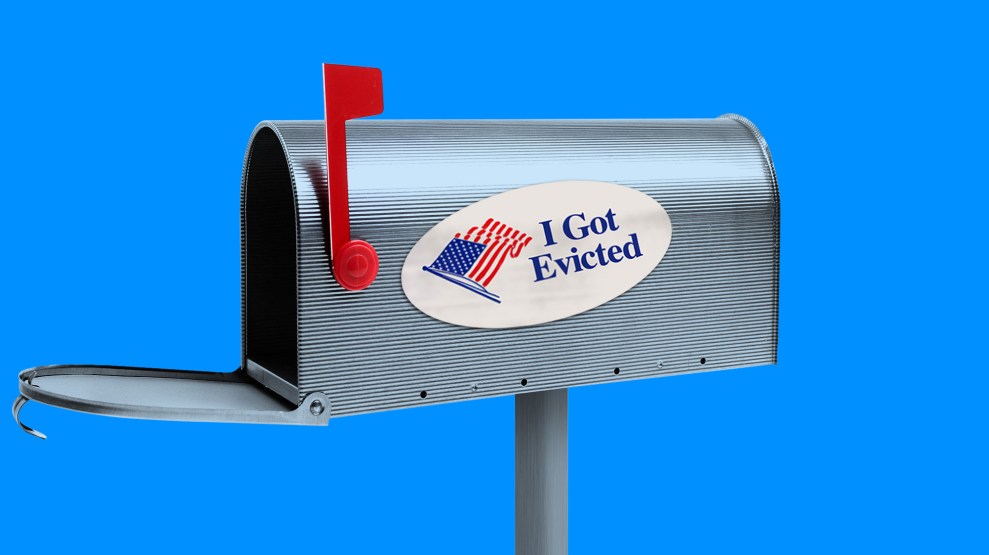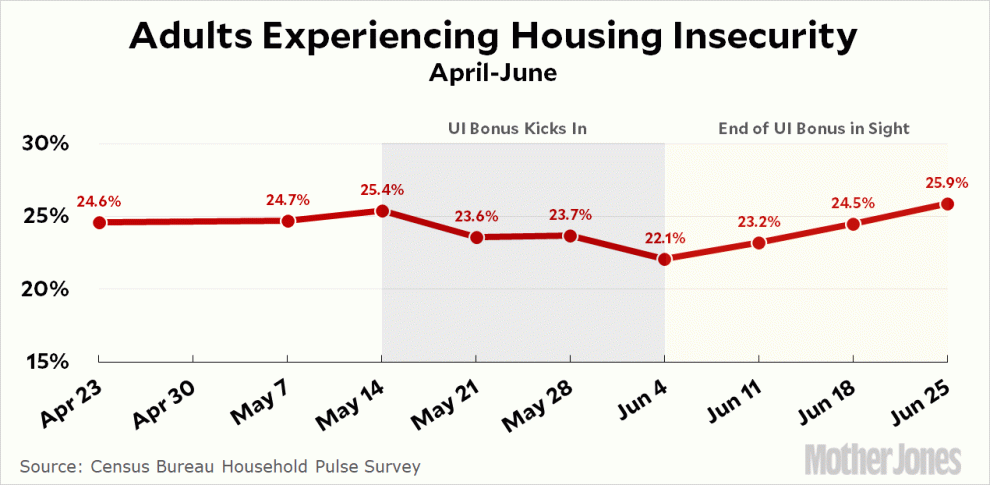
A child pulls a crab trap through the mud in Holly Beach, La., amid devastation in the aftermath of Hurricane Laura.Gerald Herbert/AP
The tenants’ rights lawyers at Lone Star Legal Aid in Houston—who represent low-income clients across 72 Texas counties and four counties in Arkansas—referred to August 25 as “doomsday.” It marked the end of the 30-day grace period following the July 25 expiration of tenant protections in effect under the CARES Act—the catchall spending bill designed to keep the country running through the pandemic that included a moratorium on evictions for federally funded housing. Time was up for the protected tenants who’d been given eviction notices. Plus, that Tuesday morning, Tropical Storm Laura was upgraded to a category four hurricane—slated to slam east Texas with force that the National Oceanic and Atmospheric Administration called “unsurvivable.” As one literal storm was forcing millions inside to seek shelter, a political and economic one was forcing thousands out of their homes. Hurricane Laura didn’t strike Houston, although it did massive damage to some parts of Texas and Louisiana.
Late summer is the height of natural disaster seasons, with wildfires in California and hurricanes and flooding across the American heartland and the South—where some of the country’s poorest residents live. The threat disasters pose is compounded by the coronavirus and its economic consequences. Amid state-level struggles to enforce safety precautions and prop up protections for the unemployed and for jeopardized businesses, up to 13 million households in the US were at risk of eviction by the end of this year by year’s end after the CARES Act had expired. Even with the additional protections, environmental and housing experts are still alarmed about the emerging crisis threatening housing insecure people across the south and west who faced not just eviction but natural disasters.
“The lowest-income people are often the people who are hardest hit by disasters, in part because they’re least financially able to evacuate before the storm,” says Diane Yentel, president of the National Low Income Housing Coalition. “I’ve never seen a moment where the housing crisis and natural disasters and pandemic have collided in this way.”
On September 1, eight days after the last CARES Act tenants’ protections expired and cleanup from Hurricane Laura had begun, the White House and the Centers for Disease Control and Prevention stepped in. They issued a surprising order that reinstated the eviction moratorium until the end of the year, in order to “prevent the further spread of COVID-19.”
“We’re going full throttle trying to get the word out to tenants that they should not vacate,” says Dana Karni, managing attorney of Lone Star’s eviction right-to-counsel unit. Even though millions of tenants—including those who do not live in federally subsidized public housing—now have protections, they come with caveats.
The CDC moratorium is highly conditional. It’s exclusively for tenants unable to make rent, who earn less than $99,000 a year. To qualify, tenants need to submit a declaration of inability to pay, confirm that they meet the income requirements, and, perhaps most difficult, prove that they’ve attempted to secure public housing. Failure to meet all these conditions risks fines and the loss of housing protection. “It’s incumbent upon legal advocacy groups and service providers to facilitate tenants in preparing those declarations in a way that is ironclad and undeniable,” Karni says. “We have concerns that landlords and judges will find whatever way possible to find justification for why a tenant should nevertheless be evicted.” After all, the moratorium does not end evictions altogether. It’s an uncomfortably narrow protection, Karni explains, that leaves open eviction for reasons beyond the inability of tenants to pay. She anticipates that people “will be cited for violating their leases as an excuse for eviction, like trash left outside, rather than evicted for not paying rent for six months.”
Karni’s fears of bad faith aren’t unfounded. When the CARES Act provisions were the primary protection for tenants, Texas courts required landlords who were filing an eviction to state that they weren’t in violation of the Act’s protections. Despite the requirement, a South Texas College of Law report on Harris County, which includes Houston, found that nearly a quarter of filings by landlords were patently false in claiming compliance with CARES protections. And the CDC order doesn’t take into consideration the host of strategies landlords have used to boot tenants, like posting notices on their tenants’ doors demanding that they vacate. And in the midst of acute economic devastation and bad-faith-eviction petitions, Karni has seen “an entire set of the population that are going through unemployment and as a result potential homelessness for the first time in ways that are mortifying and embarrassing and humbling.”
Under normal circumstances, Texas has been seen by tenant advocates as a state with limited protections. But when cases of the coronavirus spiked there in April, its Supreme Court made a surprising ruling: A moratorium on all evictions would be put in place, starting April 27. After less than a month, under pressure from the landlord lobby, which includes groups like the Texas Apartment Association, the Supreme Court opted not to extend the protections. Now, Karni says, “it seems like it was ancient history.”
Though state and CARES Act protections offered some stability, there were big cracks. Since May, Harris County has seen more than 8,000 eviction filings across court precincts, with only 3 percent of the tenants represented by an attorney. That trends lower than 2019 numbers, when there were about 65,000 filings for the entire year, but more than a third of this year’s 23,000 filings through August have occurred during a pandemic with state and federal eviction moratoriums in place. And between the end of CARES Act protections and the new CDC order announcement, almost 900 new cases were filed. Without any legal expertise, many people facing eviction leave without a fight. “It’s imperative that people remain in their homes as much as possible,” Karni says. “But I’m very keenly aware of fact that laws in Texas are not tenant friendly.”
When Hurricane Laura was bearing down on Texas and Louisiana, state officials tried to execute evacuation orders for 500,000 residents ahead of the storm’s arrival, but social distancing added a new dimension to an already complex process. Louisiana’s Department of Children & Family Services was racing to book hotel rooms so evacuees could shelter separately, while outfitting conventional shelters with supplies of masks, gloves, and COVID-19 tests. In Texas, the governor arranged for more than 400 buses to help evacuees, hoping that number would be sufficient to ensure social distancing.
Princella Talley, a diversity outreach coordinator with Citizen’s Climate Lobby—an environmental advocacy group that focuses its resources at the local level—was preparing to hunker down for the hurricane near her home in Alexandria, Louisiana, which was in the storm’s path. “Due to COVID, we sheltered in place,” she told me via email. “Social distancing was as much a priority as safely sheltering from the storm, which was frustrating. At the same time, the idea of possibly being forced to evacuate and shelter with the general public was frightening.”
Some residents in these communities, who would have preferred to prioritize escaping from Laura over the pandemic, couldn’t leave even if they wanted because they couldn’t afford it. Packing up and leaving is a resource-intensive endeavor. “Many low-income renters are holding on by a thread, and on verge of losing homes,” Yentel says, “and with COVID-19 financial fallout, can’t afford to evacuate.”
With 36 percent of Louisiana tenants facing eviction without a moratorium, the state is tied for second place among states with the highest proportion of jeopardized renters, according to the COVID-19 Eviction Defense Project. And Calcasieu Parish, which was in the center of the storm’s path, is home to 30,000 people in deep poverty, another 30,000 with a disability, and 5,000 residents who don’t have a car, according to Yentel. The timing only makes things worse. It’s the end of the month—an eternity from mid-month payday—when any discretionary spending dollars are nowhere to be found.
Yentel noted that even as so much of this is unprecedented, the imagery of destruction from a hurricane isn’t. After the storm, Talley drove through Calcasieu Parish, to the south of her home. The experience brought “an overwhelming sadness that words almost can’t describe,” she recalls. The downed power lines and trees—many of which have landed on houses—looked surreal. “Extreme weather events like this at such a high frequency keep us in an almost perpetual state of recovery,” Talley wrote in an email As electricity and power are still coming back online, the pandemic has made the need for infrastructure is especially pressing. According to the state governor, John Bel Edwards, testing sites are offline for the time being. “We don’t have the robust testing taking place across the state right now that we need in order to know if our positivity is inching up or whether we have more cases,” he said in a press briefing last Thursday.
Houston, with 3,000 eviction cases still pending that have been filed this year, was not hit by Hurricane Laura, but that doesn’t offer much consolation. The moratorium retroactively protects some tenants whose landlords filed evictions before September 1, but cases unrelated to a tenant’s ability to pay rent may go one. And hurricanes can sometimes provide unforeseen options for landlords. After Hurricane Harvey in 2017, evictions jumped as landlords who declared their properties uninhabitable voided tenant leases, leaving some residents with only five days to leave their homes. In one survey of Houston’s homeless a year after the hurricane, 18 percent reported that Harvey had unhoused them.
Even with the additional protection, Karni says the situation is more precarious than ever. Houston is an energy and services economy; the pandemic has dealt mortal blows to both. “People sitting on hefty six digit energy salaries are unemployed,” she says. “People are no longer drawing federal unemployment…most Americans statistically don’t have six months of money saved up, and even if they did, we’re there. We’re at the six month mark.” In May, the city offered its citizens $15 million in tenant relief—it was gobbled up within 90 minutes of being made available. A $45 million sequel—a combined forces effort from the city, county, and local advocacy groups—is being finalized now, but Karni says, “I think the first round was not even a drop in the bucket—this is maybe a whole drop.” What’s more, the next rent relief package, expected September 8, only permits tenants to apply for relief after their landlord has, too.
The usual option for those who lose their permanent housing is to move in with family—which is especially likely given some of the loopholes in the CDC order. And in the midst of natural disasters and the pandemic, that option contains its own problems. Crowded housing correlates with higher rates of COVID-19, which would be exacerbated by newly unhoused friends and family seeking help. If a family that has been evicted moves into a family member’s home, even more people could be exposed to either the dislocation from a natural disaster or the virus. “It’s a mess,” says Karni. “Please god may the next hurricane not bring flood water to those people, because that’s not two to three people, now, but 12 to 15.”
















